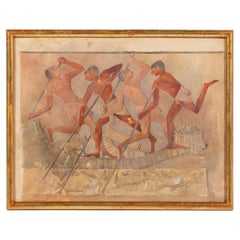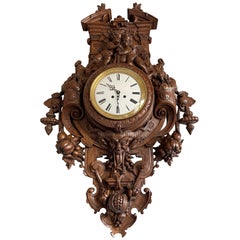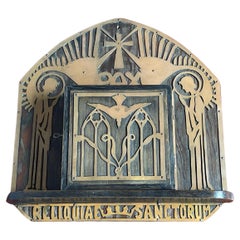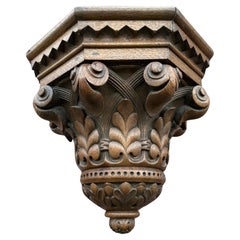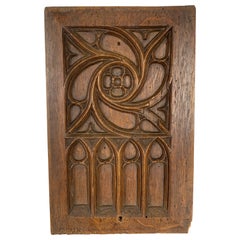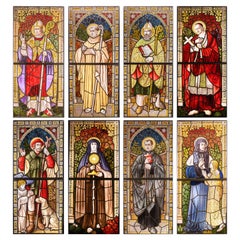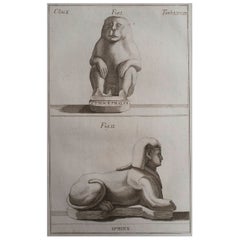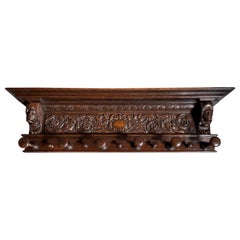Revival Wall Decorations
20
352
6
4
to
70
174
166
362
360
361
8,295
7,267
2,100
1,025
844
811
743
597
526
341
306
246
243
199
194
187
163
129
10
199
143
10
71
37
11
11
1
8
4
3
2
3
2
3
Height
to
Width
to
171
104
68
57
54
317
88
69
38
33
11
4
3
2
2
Style: Revival
Antique French Oak Gothic Revival Panel
Located in Denton, TX
French oak hand carved Gothic revival panel. There are three available. Each panel is 1" deep by 8.5" wide by 13" high.
Category
19th Century French Antique Revival Wall Decorations
Materials
Oak
Selection of eight restored 19th C Neo-Gothic Stained-Glass Windows
Located in Leuven , BE
The Color Experience: Stained-glass windows
“Color is a power which directly influences the soul” (Wassili Kandinsky, Moskou 1866 – Neuilly-sur-Seine, 1944)
“Color! What a deep and mysterious language, the language of dreams!” (« La couleur ! Quelle langue profonde et mystérieuse, le langage des rêves », Paul Gauguin, Paris, 1848-Fatu-Hiva, 1903)
‘Color and feeling’, ‘color and meaning’, these are concepts that have gone together since time immemorial. Artists and craftsmen have a special bond with color. After all, it is a means of expression that can have a real reinforcing effect. Especially linking color with light offers unlimited possibilities. Glaziers and glass painters have tried to master both these ‘instruments’ for centuries.
The set of beautifully restored neo-Gothic windows in our collection are enough reason for us to let these works of art figure in a broader story. As a bonus, we would like to introduce you to the contemporary stained-glass artist and stained-glass restorer, Daniël Theys. whose workshop is in Sint-Pieters-Rode (Belgium). He talked to us about the materials and techniques he used for the restoration of our set of neo-Gothic stained-glass windows. A fascinating look at the tricks of the trade from a specialist!
A bird’s eye view of the history of the European stained-glass window.
Although the Romans already used translucent glass plates to cover wall openings, the stained-glass window reached its peak in Europe between 1150 and 1500. A period also known as the era of the cathedrals. At that time, stained-glass windows became more than just a way to let in the light, and to keep the space closed off. From now on, their functionality was also found in their didactic value. The biblical and saints’ stories that adorned the stained-glass windows became a kind of poor man’s bible. They brought, as it were, the knowledge of the holy scriptures in an understandable, pictorial way. At the same time, the colored light provided additional symbolism. The invading light was interpreted as a manifestation of God. It is also no coincidence that the main altar was bathed in light. It was the place where the most important sacrament was celebrated, that of the Eucharist. How were these magical colors obtained? Well, during the 12th and 13th centuries, metal oxides gave color to the glass. Copper, for example, produced different colors in the various stages of oxidation. The metal could color the glass light blue, green and even red. It should be noted that from the 13th century onwards, clear glass, which was cheaper and at the same time allowed more light into the buildings, was used more often. A century later, in the years 1400 to 1500, glass painters frequently painted onto the glass with a ‘stain’ of silver chloride or sulfide. The painted piece of glass was heat-treated in a furnace. The heating process ensured that the silver ions migrated into the glass and became suspended within the glass network. The stain gave colors ranging from a pale yellow to a rather deep red. This new technique allowed glaziers to get more than one color on a single glass fragment. The shades produced by painting in silver chloride were well suited for depicting golden crowns, scepters and other gilded objects and ornaments. But the most important advantage of the technique was the fact that the glass painter could now make transitions from yellow tones to white without having to apply separations with lead strips! This also improved the legibility of the pictured scene.
You can imagine that the labor-intensive process of the production of stained-glass windows was a very costly affair and therefore it was often patrons who donated them to a church or a chapel. The benefactors were usually eager to propagate their social status and were moved by concern for their salvation.
In the 16th century, stained-glass windows also began to appear in secular buildings such as town halls, the homes of the wealthy and commercial premises such as inns. It is striking that during this period the use of lead strips that border many parts of the image was further reduced in favor of real painting on stained glass. This was due to an increasing love of detail. For example, one wanted realistically painted portrait heads. Working with enamel paints was cumbersome. Each newly applied color had to be burned into the glass before another color or overpainting could be applied. It was not only the coloring of the glass that was complicated, the process of obtaining flat glass plates required many steps as well. The glazier blew a glass bulb with a blowpipe and then cut it open. Finally, each half of the sphere was turned around so fast that it became a disc. In later periods, the glazier blew out his glass bulb into a cylinder. Once the cylinder had cooled, its closed ends were removed, and the long sides were cut open. The pieces of glass obtained were then heated and flattened. During the 16th century, there was a division of labor between the stained-glass designer, the glazier, and the glass painter. It happened as well that the stained-glass artist used prints as models for his stained-glass windows. Whoever drew the design, the glazier always needed a model on the right scale, the so-called cartoon. On the cartoon, the lead strips were clearly marked, and the use of colors was indicated. Contracts at the time show that the price of stained-glass windows was calculated per square foot. The price per square foot included the labor and material costs. The price of the cartoon was not included.
In the 17th century, the work of glass painters remained important. At the same time, there was a growing popularity of stained-glass windows with heraldic themes. In the Low Countries there were several high-quality glass painters active.
During the 18th century, glass painting went downhill in our regions. The French occupation of the Southern Netherlands resulted in the destruction and sale of religious stained-glass windows.
It was only around the middle of the 19th century that the young Belgian state experienced a revival of stained glass. The renewed interest in the Middle Ages, the so-called ‘gothic revival’, caused a wave of restoration of old stained-glass windows of churches and orders for neo-gothic stained-glass windows. The Sint-Lucas art schools in Belgium played an important role in this. Industrial developments in the glass and steel industries naturally had an important hand in the popularity of stained-glass windows. Stained-glass had a wide range of uses; think of stained glasses in winter gardens, domes, windows, and doors of large mansions. Significant glazier’ studios arose in several larger Belgian cities. In Brussels, for example, you had the workshops of Capronnier and Colpaert, in Bruges the studios of Coucke and Dobbelaere, in Ghent the companies of Ganton-Defoin or Ladon. During the 19th century, glaziers followed the style developments in the visual arts. For example, the number of windows in Art Nouveau and Art Deco style is large. The restored stained-glass windows with male and female saints that we offer for sale, come from a building in Laeken, near Brussels. They probably decorated the space of a church, chapel, convent, or Catholic school. In the results of the interview with glass restorer Daniël Theys, you will learn more about the particularities of these splendid windows.
Chatting and browsing in the workshop of Daniël Theys
The Belgian Glass restorer and glass blower, Daniël Theys (), made a career switch at a later age and has been active in the profession since 1987. He is an important player in the field of stained-glass window art in Belgium. Moreover, he is the only one in the country who still masters the technique of glass etching. Daniël Theys receives many commissions from small parish churches to restore old stained-glass windows to their former glory. He made a name for himself in that niche and that is how Spectandum brought the set of 19th century stained glass windows to his workshop for reconstruction. They were delivered in old numbered wooden crates and Daniel had to start puzzling.
Numbered wooden crates with sections of the stained-glass windows
Normally a glazier starts working from a drawing with a scale of 1:1 (full size drawing), but in this case each piece had to be cataloged and photographed. The smaller pieces were grouped on the light box and photographed in their entirety. Then Daniël made a drawing of the remaining pieces that he had puzzled together with great care.
Smaller pieces identified and grouped on the light box
The restauration guidelines of the Agency for Monuments and Landscapes are not always the same as those of a restorer. For this reconstruction, Daniël primarily considered the purpose of the stained-glass windows. It had to be an aesthetic and salable set of stained-glass windows, so the choice of filling the gaps with neutral glass or epoxy was not really an option. Theys left well-executed previous restorations untouched. The windows may have been repaired three or four times in the past.
Piece of a cloak with glass shards from different periods (restorations)
Another problem Daniel faced during the restoration was the fact that some small parts of the old grisaille had been eaten away by microorganisms. The defect – caused by moisture – can be seen from the discoloration of the grisaille. The black-brown color is turned red.
This fragment shows well how the brown grisaille has turned red due to the attack of micro-organisms
The stained-glass windows of the 19th century are made of ‘in the mass-colored’ glass. This means that the colors were added to the liquid glass during its production process. This type of glass differs from glass colored with enamel paint, which became popular from the interwar period. The latter process involves applying enamel paint (this is a glass powder with a metal oxide to which a medium has been added) to the colorless glass. When firing the glass with the enamel paint, the powder fuses with the glass. The colors of email painted glass are less intense and less brilliant than those of ‘in the mass-colored glass’.
Jars with colored powder for the enamel paints
For the restoration Daniël only worked with mouth-blown glass, both with ‘in the mass-colored glass’ and with ‘verre plaqué’. This is blown glass composed of several layers of different shades. Over the years, Theys built up a large stock of old blown glass. Colored blown glass always has sliding shades. For example, a red piece of glass can have a color transition from bright red to light orange. These differences in shades are the result of the different thicknesses of the piece of glass. It allows the glazier to use a wide variety of shades.
The purple-red foliage with light blue accents was obtained by etching away parts of a piece ‘verre plaqué’. A small part of the lower glass layer is exposed.
The windows were completely re-leaded by the restorer because there was virtually no ‘lead net’ preserved. In general, lead strips only have a limited lifespan because of oxidation processes. Daniël removed the old lead remnants and placed new lead profiles. Then he applied putty between the glass fragments and the lead strips to seal the lead. A window must be made watertight. The current condition of the windows is excellent.
Decorative glass part with original lead remnants
New lead strip
The set of stained-glass windows we present today, originally consisted of windows of 5 to 6 m high. After all, they originally adorned a neo-gothic church. Since the original dimensions are not suitable for private buildings, it was decided to only restore the figurative representation.
The original spire of one of the windows
Thanks to a suspension eye, the window can be hung. There is also the possibility to place the window in an upright position.
Thanks to the craftsmanship of the Theys-Studio, we can once again enjoy the brilliance of color!
Looking for the missing link
The set of 19th-century stained-glass windows came into the possession of Spectandum without a clear provenance. The renowned Leuven antiques dealer, Cornelius Engelen, recalls that the windows came from a church in Laeken. There is no solid starting point for a search for the provenance. Based on the style of the stained-glass windows – most probably the late 19th century -, their religious iconography, and their original shape (pointed arch windows) and dimensions (5 to 6 cm high), we can assume that they were once displayed in a (neo-)gothic cult building. On the one hand, the stained-glass windows may have been removed after storm damage or other calamities, on the other they may have been taken away during a renovation or a demolition of a church. The Church of Our Lady in Laeken is the most famous church building in that municipality that could qualify. In the early 1920s, the central windows of the transept were badly damaged by a hurricane. Today, glass fragments of these windows (dating from 1893-1894) with the names of the sixteen missing saints and an arch infill of the western window are officially known. It would be interesting to find out if our set of eight saints once were part of the transept of Our Lady in Laeken. Research in the records of the church administrators could provide clarification. Knowing that most neo-gothic stained-glass windows from the Church of Our Lady come from the Jules Dobbelaere’s glass studio in Bruges, it is useful to consult that company’s archive as well. It is kept in the KADOC (Documentation and research center for religion, culture and; in Leuven. Of course, the sizes and shape of the stone window openings of the transept can also provide an indication. If we stylistically compare the grisailles of the set of stained-glass windows with the work of Jules Dobbelaere, we do see some relationship. Especially with a stained-glass window in the chapel of Our Lady of the Saint Anthony Church in Aalst.
Another line of research that we could follow, is that of the iconography of the series. One of the saints depicted is Saint Roch. There once was a Saint-Roch church in Laeken with 19th-century stained-glass windows from the Brussels studio of Jean-Baptiste Capronnier. The company archive of the glaziers François and Jean-Baptiste Capronnier is owned by the Flemish government and can be consulted in the above-mentioned KADOC. We already searched the sales catalog of 1892, in which Capronnier’s drawings and cartoons are described one by one. The saints that are represented in our set of windows, does not correspond with the names of the saints mentioned for the church of St. Roch in Laeken. Building on this argument, it can be concluded that the eight saints were not destined for this house of worship.
In the absence of lavishly illustrated monographs on the various glazier-companies in Belgium, the execution of a comparative study of the stained-glass windows is time-consuming and complex. Although a limited number of old photos of stained-glass windows can still be found in the database ‘Balat’ of the KIK-IRPA (), this remains far too limited to get a good picture of the output of the various companies.
19th C, Saint, Neo-Gothic Stained-Glass Window with Saint Martin, Belgium, 163 x 73 cm
Most people know Saint Martin (Szombathely, ca. 316 – Candes, 397) as the Roman Tribune who cut his cloak in two with his sword and gave one half to a beggar. The artist of the stained-glass window has opted for a different, less common iconographic representation here. Saint Martin is presented as a bishop with a miter and staff. According to a legend, Martin was lured to the city of Tours with a trick to consecrate him as a bishop. He refused the ecclesiastical office and hid in a barn with some geese. The birds betrayed him with their twittering. In the end Martin received his episcopal consecration. The goose at the feet of the saint clearly refers to this event.
19th C, Saint, Neo-Gothic Stained-Glass Window with St. Angela, Belgium, 163 x 73 cm
Angela de Merici was an Italian woman who taught young women religion, health care, and household skills. She founded the monastic community of the Ursulines. They played an important social role as founders of schools and orphanages. Saint Angela died in Brescia in 1540. It should therefore come as no surprise that the saint on the stained-glass-window is depicted with
a girl by her side.
19th C, Saint, Neo-Gothic Stained-Glass Window with Charles Borromeo, Belgium, 163 x 73 cm
Charles Borromeo (Milan, 1538-1584) grew up in a noble family. He was already made Cardinal and Archbishop of Milan at the age of 24. With his writings he contributed to the implementation of the Church reforms determined at the Council of Trent. Among other things, he released a new catechism. With his book on the design of church buildings, “Instructiones Fabriacae et Supellectilis Ecclesiasticae”, he left a mark on Baroque church construction. At the outbreak of the plague in his diocese in 1576, he devoted himself to the care of those affected. Hence, people sometimes pray to him when they have been hit by a serious illness.
19th C, Saint, Neo-Gothic Stained-Glass Window with St. Roch, Belgium, 163 x 73 cm
Saint Roch (Montpellier, 1295? /1350? -1327? /1380?) was born with a port-wine stain in the shape of a cross on his left hip. It was interpreted as a sign from God. After the dead of his parents, he gave his money to the poor and went on to live the life of pilgrim. He cared for plague sufferers and healed some of them by making a sign of the cross. He is especially invoked as protector against the plague.
19th C, Neo-Gothic Stained-Glass Window with St. Bernard of Clairvaux, Belgium, 163 x 73 cm
Bernard of Clairvaux (Fontaines, 1090-Clairvaux, 1153) decided to become a monk at the age of 21. In 1112 he entered in the monastery of Cîtaux. He was soon commissioned by the abbot to find a new monastery in Clairvaux. Because of his intellectual capacities and eloquence, he was consulted by various ecclesiastical and secular leaders. He ensured the expansion of the Cistercian order throughout Europe. As a Doctor of the Church, he wrote many tracts and sermons and established a new rule for the Templars. Above all, he was concerned with the discipline of the clergy. Therefore, he wrote a spiritual manual for the priests and bishops. Saint Bernard can be seen as a true mystic. He envisioned the union of the human soul with God as the most important goal in life. According to a legend, Bernard once had a vision in which the Blessed Virgin appeared to him and strengthened him with her mother’s milk. In the arts, the saint is mainly depicted with an abbot’s staff and a book with the Cistercian rule. His vision was also often portrayed.
19th C, Neo-Gothic Stained-Glass Window with St. John Berchmans, Belgium, 163 x 73 cm
The Belgian Jan Berchmans (Diest, 1599-Rome, 1621) was the eldest of five children. When his mother became seriously ill, he initially took care of her, but at the age of nine he was housed with the town’s priest. After a few years he moved to Mechelen to become the servant of a canon. It also gave him the opportunity to begin his studies in the seminary for priests. He eventually joined the Jesuits of Mechelen. He got their permission to study philosophy in Rome. In the Eternal City, he visited working-class neighbourhoods to teach the children about God. He died of an illness at the age of 22. Saint Jan Berchmans is the patron saint of school children and students.
19th C, Neo-Gothic Stained-Glass Window with Saint Clare...
Category
19th Century Belgian Antique Revival Wall Decorations
Materials
Art Glass, Stained Glass
"Fishing in the Marsh", Framed, Watercolor, Luicenne Epron, 1876-1947, France
Located in San Francisco, CA
Wonderful watercolor and chalk work on paper by French painter, Lucienne Epron (1876-1947). Painted in the Egyptian Revival period, popular decorative arts style from 1880 through th...
Category
Mid-20th Century French Revival Wall Decorations
Materials
Paint, Paper
Antique Silver-Plated Decorative Plate Jesus Christ signed by VERNON Frederic
By Frédéric-Charles Victor de Vernon
Located in Casteren, Noord-Brabant
Beautiful antique plaque with an image of Jesus Christ with a child. The plaque is beautifully decorated, with fine details and nice engraving. The plaque is signed 'Vernon' and dated 1905.
Frédéric-Charles Victor de Vernon (17 November 1858, in Paris – 28 October 1912 in Paris), was a sculptor and engraver of French medals. He was educated at the École des beaux-arts where his teachers were Jules Cavelier, Jules-Clément Chaplain, and Émile Tasset. In 1881, he won second great Prix de Rome and in 1887 the first grand prix of Rome, after which he spent three years at the villa Médicis.
In 1900, he designed the official medals for the 1900 Summer Olympics held in Paris. These medals are unique in being the only Olympic medals...
Category
Early 1900s French Antique Revival Wall Decorations
Materials
Silver Plate, Copper
Large Scale Original Antique Print of Ancient Egyptian Sculpture. , 1776
Located in St Annes, Lancashire
Wonderful print of ancient Egyptian sculpture
Copper-plate engraving
Published by Monaldini, Rome, 1776
Good quality wove paper
Free shipping
Category
1770s Italian Antique Revival Wall Decorations
Materials
Plaster
Large Antique and Quality Carved Wooden Wall Coat Rack with Noble Men Sculptures
Located in Lisse, NL
Stunning, solid oak Dutch Renaissance Revival coat and hat rack with noble men or merchant carvings.
We all know how important first impressions are and with this stunning 19th century coat rack you will never fail to impress anyone entering your home or office. The quality of the deep and detailed carvings is wonderful and the condition is nothing short of amazing. And how about those superb condition, original solid oak hooks? They are like the proverbial cherry on the pie and they too are highly practical and very safe to hang your coats on. Because of their size, they can also be used for hats and caps. On either side of this work of art coat rack is a noble man sculpture and it is our strong belief that this particular piece was hand-crafted for a partnership of two wealthy and/or important males...
Category
19th Century Dutch Antique Revival Wall Decorations
Materials
Wood, Oak
Antique and Quality Hand Carved Solid Oak Gothic Church Wall Bracket or Shelf
Located in Lisse, NL
Great looking and deeply carved Gothic Revival bracket for displaying a Saint statue.
This Gothic console for wall mounting dates from the late 1800s and it has a marvelous combinat...
Category
19th Century European Antique Revival Wall Decorations
Materials
Brass, Metal
A fine 19th c Palatial painting entitled " Venetian Festival" by August Wolf
Located in Dallas, TX
A fine and historical Palatial oil on Canvas by August Wolf. Entitled Venetian Festival . This large oil on canvas was commissioned by Count Adolf Friedrich Graf von Schack, a colle...
Category
Late 19th Century Italian Antique Revival Wall Decorations
Materials
Canvas
Antique Gothic Revival Reliquary Wall Cabinet Brass Angels Reliquiae Sanctorum
Located in Lisse, NL
Unique and highly collectible antique Gothic wall cabinet with working lock and key.
This handcrafted and rare Gothic Revival wall cabinet from the late 1800s or early 1900s is anot...
Category
Early 20th Century European Revival Wall Decorations
Materials
Metal, Brass
Italian 19th Century Porcelain Plaque of Madonna della Primavera, after Barabino
By Nicolò Barabino
Located in Los Angeles, CA
A very fine Italian 19th century porcelain plaque of Madonna della Primavera ("Madonna detter Primavera with Bambino"), after Nicolò Barabino (1831-1891). The finely painted standing Madonna holding baby Jesus in her arms surrounded by flowers, framed in a Gothic revival style giltwood carved frame. The back inscribed: "Madonna detter Primavera - nach Barabino" and handwritten "E. Guenther, Phila". Signed lower left corner, circa 1890-1900.
Nicolò Barabino (1831–1891) was an Italian academic painter of religious and historical subjects, active in Florence and Genoa.
He was born in Sampierdarena. His initial studies were at the Genovese Accademia Ligustica di Belle Arti, under Giuseppe Isola. In Genoa, he befriended Maurizio Dufour. In 1857, he won the Durazzo scholarship to attend the Accademia di Belle Arti in Florence. He designed some of the lunettes completed as mosaics for the portals of the Florence Cathedral...
Category
Early 1900s Italian Antique Revival Wall Decorations
Materials
Porcelain, Giltwood
Large Hand Carved Antique Sculpture of Apparition of Jesus to St. Margaret Mary
Located in Lisse, NL
One of a kind, large and marvelous work of religious art.
With thanks to one of our honorable Frater clients we have learned that this unique and marvelously hand carved wall sculpture is a carving depicting the famous apparition of Jesus to the 17th century French Visitation nun, Saint Margaret Mary Alocoque. This probably is the scene in which He asks her to establish devotion to His Sacred Heart. We have never seen a sculpture of this subject matter and for us to have found one of this large size and of such quality more than made our day. Hand carved out of solid oak, both the details and the depth of this antique wall sculpture...
Category
19th Century European Antique Revival Wall Decorations
Materials
Oak
Antique & Rare Pair of Church Brackets for Saint Statues with Angel Sculptures
Located in Lisse, NL
All handcrafted and matching pair of colorful & meaningful church wall brackets / shelfs.
If you are a private collector of ecclesiastical art or if you are looking for the perfect ...
Category
Early 20th Century European Revival Wall Decorations
Materials
Wrought Iron
Antique Fine Handcarved Oak Gothic Revival Wall Shrine / Chapel for Statuette
Located in Lisse, NL
Rare and good condition, Gothic-art shrine for standing or wall-hanging.
This handsome and decorative, Gothic wall shrine is completely hand-crafted out of solid oak and it will look awesome, no matter where you decide to mount or place her. It must have taken its creator quite a few days to first draw this intricate design on paper and then hand carve the entire piece out of solid oak. The Gothic Style elements are deeply handcarved in both doors and they make this shrine highly decorative and an absolute joy to own and look at. This cabinet chapel (or chapel cabinet) comes with its brass lock in perfect working order and also with its original gothic style key. The handgrip is in fact a Gothic trefoil symbol (for the trinity). What also makes this piece extra attractive is the Gothic church window-like frame behind the doors. It is among the finest we have seen to date and on top of that this antique also has a beautiful and rich patina. By the way, the bronze Mary statuette is not included in our price. Finally, thanks to the hook in the back, mounting this antique chapel...
Category
Early 20th Century French Revival Wall Decorations
Materials
Brass
Antique and Quality Hand Carved Oak Gothic Church Wall Bracket or Shelf / Table
Located in Lisse, NL
Wonderful and superbly hand carved, 19th century Gothic Revival bracket / side table.
This all handcrafted, Gothic Revival wall bracket has the ideal size and shape to be used as ...
Category
Late 19th Century Dutch Antique Revival Wall Decorations
Materials
Wood, Oak
Antique Hand Carved Gothic Revival Wall Bracket or Shelf for a Saint Statue
Located in Lisse, NL
Good size and great looking Gothic Revival bracket for displaying a statuette.
This Gothic console for wall mounting dates from the early 1900s and it has the most timeless design a...
Category
Early 1900s European Antique Revival Wall Decorations
Materials
Metal
"Hunting in the Marsh", Framed, Watercolor, Luicenne Epron, 1876-1947, France
Located in San Francisco, CA
Wonderful watercolor and chalk work on paper by French painter, Lucienne Epron (1876-1947). Painted in the Egyptian Revival period, popular decorative arts style from 1880 through th...
Category
Early 20th Century French Revival Wall Decorations
Materials
Paint, Paper
Baroque Style Hand Carved Wooden Crucifix with Stunning Bronze Corpus of Christ
Located in Lisse, NL
Crucifix from the mid-1800s with a carved shroud or veil depicting Christ in the base.
This unique and remarkable antique crucifix can both be used as a table and as a wall crucifix. Over the decades we have sold a number of unique and very well crafted crucifixes, but never one in the Baroque style with this combination of materials and techniques. The overall design and size is what stands out first, but the details and the materials are what make this antique work of religious art extraordinary. With four angels (or putti) watching over a sculpture of the Veil of Veronica, the relatively large base of this unique crucifix is a work of religious art in its own right. It is almost as if the cross is growing from this beautiful base and the cross itself too comes with a number of superbly hand carved details. To us, the most remarkable are the three stunning Baroque shells. With their symbolic meaning of birth and resurrection it is obvious why the artist / sculptor so tastefully incorporated them here. Apart from a minor 'lean' to the left, the cross itself too is in excellent condition. If one were to speak of a trinity in this crucifix then the unique base and cross are completed with an equally striking, solid bronze corpus of Christ...
Category
Mid-19th Century European Antique Revival Wall Decorations
Materials
Bronze
Antique & Huge Hand Carved Wall Clock by Parisian Top Makers Guéret Frères 1860s
Located in Lisse, NL
One of a kind wall clock by world famous Parisian makers and master carvers.
This antique oak wall clock was all handcrafted and handcarved by the world famous Guéret Frères. This f...
Category
Mid-19th Century French Antique Revival Wall Decorations
Materials
Gold Leaf, Bronze, Metal, Enamel, Brass
"Paris Sentinels" Etching by John Taylor Arms
Located in Toledo, OH
This etching by John Taylor Arms is titled "Paris Sentinels." John Taylor Arms(1887-1953) was a famous printmaker in the early 20th century. He studies to be an architect and thought...
Category
1920s Vintage Revival Wall Decorations
Materials
Paper
"Gargoyle Studies" Etching by John Taylor Arms
Located in Toledo, OH
This etching by John Taylor Arms is titled "Gargoyle Studies." John Taylor Arms(1887-1953) was a famous printmaker in the early 20th century. The image is 3" x 3" and framed and matt...
Category
1920s Vintage Revival Wall Decorations
Materials
Paper
A carved fir wood bas-relief with the profile of the Virgin Mary - Italy - 1960
Located in SOTTEVILLE-LÈS-ROUEN, FR
A carved fir wood bas-relief depicting the profile of the Virgin Mary. Adorned with the sacred inscription 'Regina Pacis', this piece evokes the serenity and maternal protection of t...
Category
1960s Italian Vintage Revival Wall Decorations
Materials
Pine
Enameled Painting On Porcelain Plate From The End Of The 19th Century
Located in MARSEILLE, FR
Very large enameled plaque on porcelain representing an interior scene from the Middle Ages. Precious technique of relief enamels intended mainly for decorating quality lady's dresse...
Category
Late 19th Century French Antique Revival Wall Decorations
Materials
Porcelain, Wood
Large decorative and theatrical painting signed Gatti from the 60s
By Gatti
Located in Grenoble, FR
this large painting found in the back of a workshop has never been exhibited, it is still rolled up. This is certainly a request for decor for a theater or large restaurant as was do...
Category
Mid-20th Century French Revival Wall Decorations
Materials
Korhogo Cloth
Wayne Carlson Handprinted Gold and White Wallpaper, Trompe L’oeiul Classical
Located in Brooklyn, NY
Wayne Carlson Handprinted Gold and White Wallpaper, Trompe L’oeiul Neo-Classical Revival.
One opened vintage roll of gold on white hand-printed wallpaper by Wayne Carlson. The scen...
Category
Early 20th Century American Revival Wall Decorations
Materials
Paper
Antique Gothic Revival Hand Carved Oak Wall Cabinet with Green Cathedral Glass
Located in Lisse, NL
Unique and striking Gothic Revival wall cabinet with perfect working lock and key.
This handcrafted and probably unique Gothic Revival wall cabinet from the late 1800s is another one of our magnificent recent finds. The size, the quality in the large amount of hand-carved Gothic details, the patina and the excellent condition make this another perfect purchase for collectors of this ancient and highly decorative style. The overal design, including the Gothic church window in the door, is right up there with the best we have seen to date. However, what makes this Gothic work of beauty really stand out for us, is the combination of the patina of the light tiger oak and the perfect condition, green cathedral glass panel in the door. That combination truly is a joy to look at. The door, by the way, still opens and shuts tight perfectly and it comes with a perfect working lock and key. Have you also noticed the original, gilt bronze lock plate? That is a work of art in its own right. The clean inside of this cabinet comes with two removable, solid oak shelves and the inside of the door is veneered with a wonderful bird's eye maple. On the back of this unique and antique Gothic cabinet...
Category
Late 19th Century European Antique Revival Wall Decorations
Materials
Metal, Bronze, Brass
Gothic Revival Quatrefoil Design Umbrella & Stick Stand w. Hand Painted Irises
Located in Lisse, NL
A fine work of Gothic Art depicting iris flowers, associated with the Passion of Christ and the Resurrection.
This Gothic quatrefoil design umbrella stand is another one of our rece...
Category
Early 20th Century European Revival Wall Decorations
Materials
Wrought Iron, Zinc
Antique Swedish Empire Wall Cabinet 19th Century Walnut Gilt Bronze Hanging
Located in Ijzendijke, NL
Gorgeous & stylish Swedish wall cabinet in Empire style 19th century. with carvings in walnut & gilt bronze decorations
Really nice solid wood quality with hand carved decorations. ...
Category
Late 19th Century Swedish Antique Revival Wall Decorations
Materials
Bronze
"Guardian of the Spire" Etching by John Taylor Arms
Located in Toledo, OH
This etching by John Taylor Arms is titled "Guardians of the Spire." John Taylor Arms(1887-1953) was a famous printmaker in the early 20th century. This etching features two griffin ...
Category
1920s Vintage Revival Wall Decorations
Materials
Paper
2 Large Scrolled Acanthus Gold Gilt Wood Corbel Wall Bracket Sconce Shelves 20"
Located in Dayton, OH
Pair of vintage 20th century giltwood corbels / wall brackets, featuring a grooved scrollwork body embellished with acanthus leaves. Rectangular top with clipped corners and foliate ...
Category
Late 20th Century Revival Wall Decorations
Materials
Giltwood
"Watching the People Below" Etching by John Taylor Arms
Located in Toledo, OH
This etching by John Taylor Arms titled "Watching the People Below." John Taylor Arms(1887-1953) was a famous printmaker in the early 20th century. This piece features a griffin o to...
Category
1920s Vintage Revival Wall Decorations
Materials
Paper
Antique Crucifix with Exceptional Bronze Sculpture of a Suffering Jesus Christ
Located in Lisse, NL
Amazing antique bronze sculpture of Jesus on the cross.
This bronze sculpture of Christ is a powerful reminder of His agony and suffering on the cross. Much has changed in society s...
Category
19th Century European Antique Revival Wall Decorations
Materials
Brass, Bronze, Metal
19th Century American Greek Revival Broken Pediment
Located in Chicago, IL
Crafted with meticulous attention to detail, this exquisite 19th-century American Greek Revival broken pediment is a classical architectural masterpiece featuring intricate dentil mo...
Category
19th Century American Antique Revival Wall Decorations
Materials
Wood
Antique Circa 1900 Architectural Watercolor Painting
Located in Seguin, TX
Architectural rendering in watercolor, gouache, and pencil on paper by Luiz Olivieri Italy/Brazil, circa 1900. Unsigned. Unframed, age toning, edge losses.
Category
Early 20th Century Brazilian Revival Wall Decorations
Materials
Paper
Antique Circa 1900 Architectural Rendering Watercolor Painting
Located in Seguin, TX
Architectural rendering in watercolor, gouache, and pencil on paper by Luiz Olivieri Italy/Brazil, circa 1900. Unsigned. Unframed, age toning, edge wear.
Category
Early 20th Century Brazilian Revival Wall Decorations
Materials
Paper
Antique Greek Orthodox Icon "The Annunciation of Mary" Egg Tempera Gilt 1750
Located in Portland, OR
A fine antique 18th Century Greek Orthodox icon, egg tempera & gold leaf on wood panel, circa 1750.
The icon depicts the Annunciation of the Virgin Mary, to the left is the Angel Gab...
Category
1750s Greek Antique Revival Wall Decorations
Materials
Gold Leaf
Richly decorated neo-gothic frame with colored photo of a school director, Belgi
Located in Meulebeke, BE
Belgium / 1925 / Neo-gothic frame with colored photo / neo-gothic
An exquisite wooden neo-gothic frame with the photo of a priest and the head of a school for arts and crafts. Made ...
Category
1920s Belgian Vintage Revival Wall Decorations
Materials
Wood
Anonymous, Drawing of Stretching Man, French, c. 1930
Located in Brooklyn, NY
Anonymous, Drawing of Stretching Man, French, c. 1930
ink, graphite
H: 16.6 by 13 by 2.75 in.
Original Frame
Category
1930s French Vintage Revival Wall Decorations
Materials
Oak
Antique Russian Orthodox Icon St. Helena & Constantine Marcarius True Cross 1820
Located in Portland, OR
A fine & large antique Russian Orthodox icon, circa 1820.
This large antique Russian icon painted with egg tempera on wooden panel, depicts the "True Cross" to the center with Saint...
Category
1820s Russian Antique Revival Wall Decorations
Materials
Wood, Paint
Elise Puyroche-Wagner (German, 1828-1895), Floral Naturalistic Painting C. 1853
Located in Atlanta, GA
Elise Puyroche-Wagner (German, 1828-1895), circa 1853. Oil on Canvas in Giltwood Frame.
An extremely fine painting featuring a naturalist floral scene, flowers, grapes, peaches, an...
Category
Mid-19th Century German Antique Revival Wall Decorations
Materials
Canvas, Giltwood, Paint
Exceptional Pair of Carved Wall Brackets with Mythological Faces
Located in San Francisco, CA
An exceptional highly carved pair of walnut wall brackets consisting of dramatic well-carved faces of mythological creatures with wide eyes, opened mouths and wild flowing hair. Subs...
Category
Late 19th Century English Antique Revival Wall Decorations
Materials
Walnut
Robert Pansart Églomisé Glass Mirror Wall-Mounted Panels Set, Asian Character
Located in Atlanta, GA
Robert Pansart (1909-1973) designed this stunning pair of églomisé mirrored glass wall-mounted panels in the 1940s. The panels feature an elongated shape with an Asian-inspired desig...
Category
1940s French Vintage Revival Wall Decorations
Materials
Glass, Mirror, Wood
The model, 1883 - Albert F.A. LAURENS (1864-1934)
By Paul Albert Laurens
Located in PARIS, FR
Very large oil on canvas (2.10 m x 1.45 m), of a young woman leaning on a sculptor's easel, probably resting between two posing sessions.
Nude, adorned with gold and silver jewels, p...
Category
Late 19th Century French Antique Revival Wall Decorations
Materials
Canvas
Young woman with mask, Henri SERRUR, 1844
Located in PARIS, FR
Portrait of a young woman dressed as a shepherdess, holding a Columbine mask in her right hand.
Signed SERRUR in the middle right.
This is probably a costume worn by the young woman ...
Category
19th Century French Antique Revival Wall Decorations
Materials
Canvas
Hand Carved Renaissance Revival Wall Mirror with Lidded Gloves & Scarf Box 1890s
Located in Lisse, NL
Exceptional antique hallway mirror with hand carved lions sculptures.
This stunning, Dutch Renaissance Revival entry hall mirror is a marvelous antique to come home to, but it also ...
Category
Late 19th Century Dutch Antique Revival Wall Decorations
Materials
Zinc, Brass, Iron
French Neoclassical Revival Style Stained Glass Panel Praying Angel or Cupid
Located in Los Angeles, CA
A French early 20th Century Neoclassical Revival stained glass panel depicting a praying angel or cupid. The charming oval shaped hand-painted multi-colored glass panel or window dep...
Category
Early 1900s French Antique Revival Wall Decorations
Materials
Art Glass, Stained Glass
Set of 18 Gothic Architectural Prints ( Scotland ) After Robert Billings. 1848
Located in St Annes, Lancashire
Glorious set of 18 prints of Gothic Architecture in Scotland
Steel engravings. After R.W. Billings
Published by William Blackwood & Sons, Edinburgh. Dated 1848
Unframed.
Category
1840s Scottish Antique Revival Wall Decorations
Materials
Paper
"Nude and Horsedrawn Chariot, " Rare Bronze Plaque by Barbedienne
Located in Philadelphia, PA
Beautifully modeled, cast and finished, this high-relief plaque of a nude male figure followed by a four-horse chariot driven by a robed female figure was produced the famous Barbedi...
Category
Early 20th Century French Revival Wall Decorations
Materials
Bronze
Ukrainian Woman in Peasant Dress with Rake
Located in Sharon, CT
Beautifully painted oil on board, Soviet genre study of a peasant woman in traditional dress with a rake resting on her shoulder. Framed 20" x 17".
Category
Early 20th Century Ukrainian Revival Wall Decorations
Materials
Wood
Large Antique Magnificently Carved Renaissance Revival Wall Mirror with Angels
Located in Lisse, NL
Majestic entrance or fireplace wall mirror with shelf.
When we first saw this stunning antique mirror we immediately knew we had to have it. Also, because we felt this rare size an...
Category
Late 19th Century European Antique Revival Wall Decorations
Materials
Zinc, Metal
French Troubadour School Flat Rest In Copper 19th Century - France
Located in Beuzevillette, FR
Pretty embossed copper plate representing a tavern scene in the style of the 16th century. In a renaissance interior four men are drinking, three of them lift their cups, the fourth,...
Category
Mid-19th Century French Antique Revival Wall Decorations
Materials
Copper
Silver framed Medallion, George Washington by Bert Bentley, Wedgwood, circa 1925
By Wedgwood
Located in Melbourne, Victoria
A portrait medallion of George Washington, in pale blue jasperware, and set in a quality frame of silver, reeded and cross-banded. Decorated by Bert Bentley, one of the best of the e...
Category
Early 20th Century English Revival Wall Decorations
Materials
Stoneware
Bronco Garden Wallpaper
Located in București, RO
The Bronco Garden wallpaper model combines the refinement of works of art with the luxury of designer decorations. Statement. Sting. Unforgettable. This mix participates in the exper...
Category
2010s Romanian Revival Wall Decorations
Materials
Other
Early 19th Century Framed Lithograph by Jean Baptiste Madou
Located in Dallas, TX
Early 19th century framed lithograph by Jean Baptiste Madou (1796-1877) is a remarkable work entitled
Les Aquarelles depicting a gathering of the well-heeled of early 19th century F...
Category
1820s French Antique Revival Wall Decorations
Materials
Paper
Madonna & Child Painting by Rebecca De Leon Almazan
Located in Seguin, TX
Oil on canvas painting of Madonna and child by Rebecca de leon Almazon (1935-2018) Texas. Unsigned, from the artists estate, likely unfinished. Unframed.
Category
Late 20th Century American Revival Wall Decorations
Materials
Canvas
Antique Hand Carved Pair of Nutwood Egyptian Male & Female Priest Sculptures
Located in Lisse, NL
Stunning and almost 4 feet tall, Egyptian Revival wall sculptures.
This rare and striking pair of hand carved Egyptian sculptures is another great example of the quality of the craf...
Category
19th Century European Antique Revival Wall Decorations
Materials
Nutwood
Antique French Cast Iron Fire Back "The Salamander of Francois" Fireplace Hearth
Located in Tyler, TX
SUPERB and RARE Antique French Cast Iron Fireplace Fire Back ~~c. 1890s
This HANDSOME statement piece will add charm and character to your home or...
Category
Late 19th Century French Antique Revival Wall Decorations
Materials
Iron
Triangle Floating Shelves
Located in Oxford, GB
This handcrafted triangle floating shelf is made of natural materials, specifically pencil reed rattan. Its quality construction adds a touch of elegance to any space. Organization m...
Category
2010s Philippine Revival Wall Decorations
Materials
Rattan
Pair of panels, Dancers. Molded alabaster. 20th century, after CANOVA, Ant
Located in Madrid, ES
Pair of panels, Dancers. Molded alabaster. 20th century, inspired by CANOVA, Antonio (1757-1822).
Pair of reliefs with frames made of alabaster molded with polychrome, inspired by t...
Category
20th Century Spanish Revival Wall Decorations
Materials
Other
Revival wall decorations for sale on 1stDibs.
Find a broad range of unique Revival wall decorations for sale on 1stDibs. Many of these items were first offered in the 21st Century and Contemporary, but contemporary artisans have continued to produce works inspired by this style. If you’re looking to add vintage wall decorations created in this style to your space, the works available on 1stDibs include wall decorations and other home furnishings, frequently crafted with wood, glass and other materials. If you’re shopping for used Revival wall decorations made in a specific country, there are Europe, France, and Italy pieces for sale on 1stDibs. While there are many designers and brands associated with original wall decorations, popular names associated with this style include and Robert Pansart. It’s true that these talented designers have at times inspired knockoffs, but our experienced specialists have partnered with only top vetted sellers to offer authentic pieces that come with a buyer protection guarantee. Prices for wall decorations differ depending upon multiple factors, including designer, materials, construction methods, condition and provenance. On 1stDibs, the price for these items starts at $1,396 and tops out at $9,500 while the average work can sell for $2,175.
Recently Viewed
View AllMore Ways To Browse
Copper Leaf Frame
Gordon Antique Furniture
Antique Furniture Forum
Antique Hand Colored Photograph
Antique Handwriting
Malta Antique
Model Car Wall
Sheep Mount
Vintage Cambodian
18th Century Canadian Furniture
Antique Gent
Easel Light
English Hunt Scenes
Lighted Easel
Used Furniture Colorado Springs
A Million Times
Antique Furniture Somerset
Book Wallpaper
